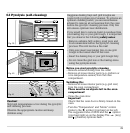
28
6.1 Manual cleaning
Caution, risk of burns! Wait until the oven has
cooled down to be touched safely before
cleaning.
Do not use any scouring cleaning agents,
aggressive or nitro-polishing agents, scouring
pads or other tools.
Thoroughly clean the appliance before operating it
for the first time and after every use, thus avoiding
the residues baking in. After residues have baked
in several times, they are then difficult to remove.
Clean the oven with hot soapy water while it is still
warm and leave it open to dry. Do not scrape off
baked-in remainders of food. Instead, moisten them
with a wet cloth and detergent.
Fruit juices from moist cakes dripping onto the oven
interior can damage the enamel. Remove such
soiling as soon as the oven has cooled down
sufficiently.
Do not use commercially available oven sprays to
clean the oven.
Clean accessories (baking tray, grid iron and grill
pan) with hot water or detergent.
Clean the control panel, glass surface and
operator controls with a moist cloth and mild
soapy water and dry them with a soft dry cloth.
Do not use any commercially available stainless
steel cleaners or highly alkali cleaners (for example
oven cleaning spray) for the control panel as
these can damage the panel and the printed
symbols. Do not use any abrasive sponges either.
Do not use scouring agents or abrasive sponges to
clean the glass front. Use commercially available
window cleaning detergents and apply them on a
soft, moist cloth or a window leather. Do not spray
onto the control panel.
Cleaning the baking stone (special accessory)
Remove coarse soiling from the baking stone. Turn
the baking stone round before using it again. This
will ensure self-cleaning. Dough residues can then
be removed using a soft brush.
Note: Do not clean the baking stone with water and
detergents.
6. Cleaning and care
50
0
150
175
200
300
250
125
0
100
75
50
Fig. 38
Note:
Do not use high-pressure or steam jet cleaning
devices to clean the appliance – risk of short-
circuit occurring.


















